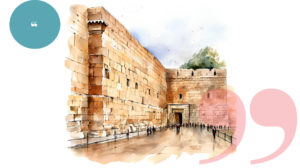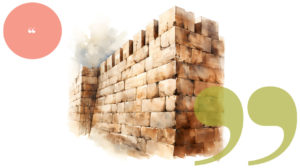Luck of the Draw

Purim is a time of immense love — it’s a stick of dynamite, with the power to remove that wall that separates us from Hashem in one blast

Purim. We’re so used to the name of the day, we don’t give it a second thought.
But names are significant, they express and reflect the essence of that thing. On Pesach, we celebrate Hashem passing over our homes at the moment of redemption. Sukkos reminds us of the love Hashem expressed by surrounding us by His seven clouds of glory in our sojourn in the desert. However, the name Purim — lots — seems to reflect an ancillary aspect of the Purim story. Why was this special day not named after a facet of our salvation?
Bad Luck?
Rabbi Chaim Friendlander, in Sifsei Chayim, traces the lottery motif through Torah. The most obvious use of a lottery took place on Yom Kippur when the Kohein Gadol cast lots deciding the two goats’ fates. Eretz Yisrael was divided among the shevatim through a lottery system. In these cases, the lottery in effect transferred the decision directly to the Almighty.
In the Purim story, Haman cast two lotteries, one for the month, one for the day (hence the plural — Purim) believing that it would be decided by chance. In this act, Haman showed that as well as being Amalek’s physical descendent, he was spiritual heir to Amalek’s worldview.
Amalek is described as having “chanced (karcha) upon us on the way” and he championed the belief that the events of this world are born of chance, and that there’s no guiding force that drives this world. Haman himself uses a similar expression, and Mordechai uses the word karahu to hint to Esther at the source of their enemy’s spiritual power. The name of the holiday comes to underscore the philosophy of Amalek in contradistinction to Yiddishkeit. It is no wonder that Hashem’s name does not appear in the Megillah — it emphasizes that Hashem is everywhere, directing the world, even when He isn’t seen.
This message is also highlighted by the minhag to wear masks on Purim. Rabbi Tatz points out that when two people are very far away, there’s no need for a mask: the very distance obscures our vision, and the two people will be unable to recognize it. A mask is only necessary when two people are in close proximity, and one wishes to remain unseen.
We live in a masked world. Hashem’s Hand is hidden, and at times it feels like He is so very far away. But it is the very concealment that gives us encouragement and chizuk. For Hashem can only draw close to us if He’s obscured in some way. The knowledge of His closeness is transformative. It prods us to open our arms to receive His embrace, instead of closing our arms tightly around us, and turning our backs on Him, chas v’shalom.
But it’s a battle. And it’s such a fundamental battle that Purim was called after Haman’s lottery — a constant reminder that all that happens to us, every difficult situation or challenge we face, is not by chance. All is orchestrated directly by Above, in an act of love and closeness.
Rav Aharon from Karlin takes this idea one step deeper. The Megillah states that the lots were cast in front of Haman, but it doesn’t state who casts the lots. Rav Aharon notes that it was none other than Hashem who was casting the lots, and deciding the exact date when the Jews would face mortal threat. We know that each month of the year corresponds to a different part of the body. The Bnei Yissaschar explains that Adar corresponds to the nose, to the sense of smell. In Gan Eden, the sense of smell was the only one left unsullied: the other four senses were involved in the sin of eating from the Tree of Knowledge.
When the Jews gathered together and ate at the feast of Achashveirosh, they were reenacting the sin of Adam Harishon eating from the Eitz Hadaas. Hashem therefore made the lot fall out on Adar: the power of the month, that pure sense of smell, would act as a protection for the Jews. It’s no coincidence that both Mordechai and Esther’s names were connected to the sense. The name Mordechai is related to the spice mor dror, and Esther’s other name was Hadassah, the sweet-smelling myrtle.
No wonder we have a special mandate to rejoice on Purim: what greater simchah than knowing that every aspect of our lives — both the good and bitter — is intimately directed by the One Above. Just as He was involved in choosing the exact month for the decree, He calculates every event. As we say every morning in Baruch She’amar, Hashem is gozer umkayem — He enacts a decree and creates all the necessary circumstances to enable us to endure.
Intense Connection
The Nesivos Shalom notes that the name Purim links this holiday with the holy day of Yom Kippurim or k’Purim. Both of these days are times of intense connection: Yom Kippur through fear, and Purim from a place of love. There are two ways to knock down a brick, he notes. One can demolish by removing one brick at a time, painstakingly and laboriously. Or one can place a stick of dynamite by the wall. The blast will topple the structure in one big bang.
On Yom Kippur, we remove each aveirah brick by brick: each al cheit does its work and the accumulation clears a pathway to Hashem. Purim, though, is a time of immense love — it’s a stick of dynamite, with the power to remove that wall that separates us from Hashem in one blast. Purim is an exalted es ratzon, and our prayers on this day have such an intense power that they can reverse decrees that have already been sealed. No wonder the halachah of “all who extend a hand in request are given” is ascribed to Hashem as well. He waits for us to make special requests on this spiritually explosive day.
Rav Pincus notes that the time of the Megillah is a particularly auspicious time to daven. On this extremely busy day, women can take advantage of five or ten minutes after the Megillah reading to spend time in private tefillah. The seudah is another powerful time to make requests, wherein the “King” turns to each one of us (just as Achashveirosh did at the party Esther made for him) and asks us to name our hearts desire. Spending a few moments during the meal davening, or saying Tehillim for specific requests has a tremendous power.
Some women manage to get up early and daven netz on Purim, knowing that this is the only quiet time they’ll get in the very hectic day. Others have a short Tehillim group right after Megillah wherein they say the booklets of Tehillim to complete the whole sefer together. With proper planning, one can find small pockets of time when one can focus on tefillah. Even just placing a Tehillim in the car, so that one can say a chapter or two while the children deliver their mishloach manos, can help us to take advantage of the day.
The Nesivos Shalom brings a mashal of a king who wanted to transport his crown from one place to another. If he used the royal coach, there was a chance that his crown would be stolen by robbers. Therefore, the king placed the crown in an old wagon and covered it in rags, so no one would pay attention to the contents of the wagon.
To mask the immense power of Purim, the day is full of raucous music, drinking, and dancing. But a wise man will know that within these mundane activities, Hashem’s very crown is being transported. Although Purim is a frenzy of torn costumes, knocks at the door, collectors, sugar highs, food preparation, and cellophane, we need to tap into its power, which is akin to the immense sanctity of Yom Kippur.
Every Small Crumb
A final approach to the choice of the name of the holiday is found in Rav Meizlish’s sefer, Sichos Bavodas Hashem. The gemara tells us that the seventh day of the party, when Vashti was called in to Achashveirosh, was Shabbos. This was no mere coincidence.
Though as far from any Shabbos meal as could be imagined, Chazal tell us that as the Jews partook of the seventh day of this party, they sang zemiros and said divrei Torah. Although they sinned at the party, their salvation ultimately came from the aftermath of the orgy, with the demise of Vashti.
The Sod Yesharim notes that the name Purim is related to the word perurim, crumbs. Purim is a time when we see how Hashem values and loves even the smallest mitzvos that we do — the crumbs of goodness. The divrei Torah at that meal, as insignificant as it may have seemed, created the fruit of our salvation.
As the Megillah reaches its final triumphant conclusion, we’re told that the Jews had “light and happiness, joy and glory.” Famously, Chazal give an additional interpretation to each of these terms: the Jews had Torah, Yom Tov, milah, and tefillin. But what does this mean, asks Rav Schwab? The decree against the Jews was for their physical destruction, Haman sought the obliteration of our nation, but unlike the Greeks, he did not enact laws against performing the mitzvos. There was no religious persecution.
Rav Schwab brings a beautiful explanation. True, the Jews had Torah. But they had Torah without light. They had Yom Tov, but without joy. They had milah and tefillin, but their hearts did not lift in celebration when they performed these mitzvos.
Purim is the time when we reaccepted the Torah from love, when we recognized the preciousness in every single mitzvah. When we saw that every small deed, every “crumb” (perurim), is special to Hashem.
Within the day’s frenzy lies spiritual dynamite. Prayer. Return. A deep understanding that all the events in our lives are orchestrated by the One Above — with love. Within Purim lies the power to transform our lives forever.
(Originally featured in Family First, Issue 484)
Oops! We could not locate your form.











